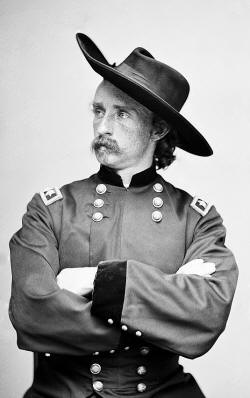|
When
General Phil Sheridan reorganized the Cavalry, Custer kept his
command, and fought in the Battle of the Wilderness, and in the
Shenandoah battles.
At the end of September 1864, he was
chosen to lead a division, and on October 9, 1864 he fought in the
cavalry action known as the battle of Woodstock. Soon afterwards he was
made brevet-major-general of the United States Volunteers. He played an important role in the battle of Cedar Creek. He was with
Phil Sheridan in the last great cavalry action of the Civil War,
and won the battle of Waynesboro, and added to his notoriety by his
accomplishments at Dinwiddie and the Battle of Five Forks.
His actions were particularly noteworthy
in the battles immediately preceding the surrender of Lee at Appomattox
Court-house. He was exceptionally fortunate in his military career
during the Civil War, and was made lieutenant-colonel of the 7th Cavalry
in 1866, receiving the brevet of major-general, U. S. A, for services
ending in Lee's surrender.
Custer participated in General Winfield
Scott Hancock's actions against the Cheyenne Indians, and he dealt a
stunning defeat to them at the battle of Washita river on the November
27, 1868.
In 1873 General Custer relocated to the
Dakota Territory to bring war to the
Sioux. In 1876 an Custer's regiment was part of an action against the
Sioux Indians, and their allied tribes. Serving as the advanced guard
for the soldiers under Terry, Custer's unit arrived at the intersection
of the Little Big Horn and Big Horn rivers in Montana. Custer's force
arrived on the night of June 24, and was anticipating the arrival of the
main body of Terry's command on June 26th.
Custer detected the presence of what he
thought to be a small isolated force of Indians. Not waiting on the
balance of Terry's Army, Custer decided to attack on the 25th. He
divided his troops into three parts, and advanced to surround the Sioux.
Instead of meeting only a small force of Indians, the 7th Cavalry was
attacked by the full forces of the Sioux and their Allies. Custer's two
flanking columns were able to maintained themselves until Terry arrived.
George A. Custer and 264 men of the center column rode into the midst of
the Sioux warriors, led by Sitting Bull, and were slaughtered to the
last man. This great battle, the Battle of Little Big Horn is popularly
known as "Custer's Last Stand". In 1879 a statue of General Custer was
erected at West Point. |
